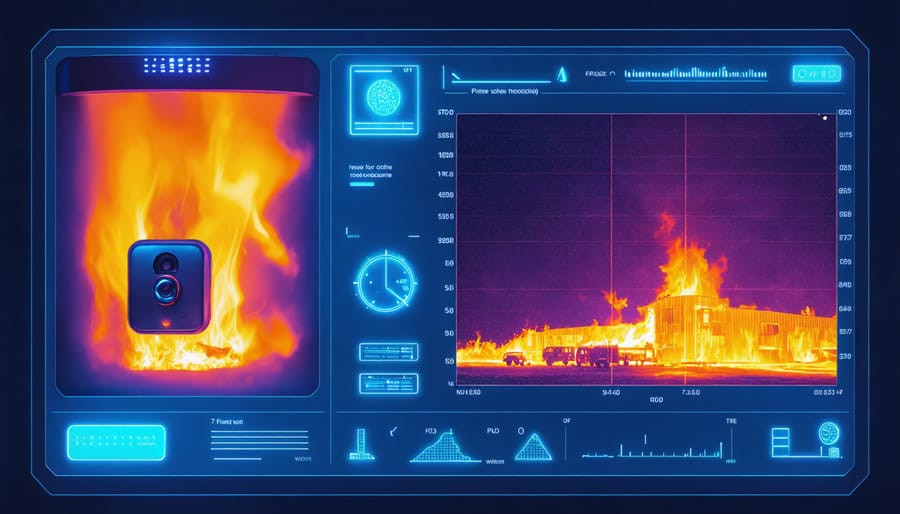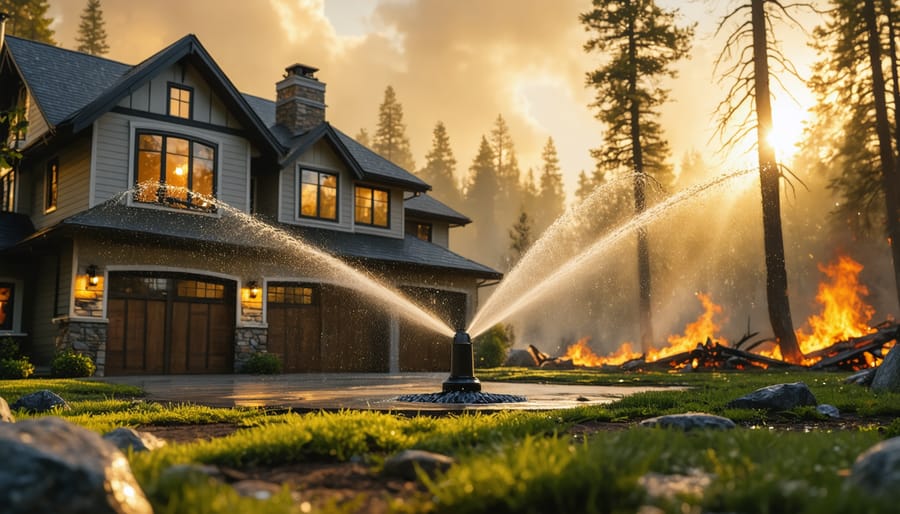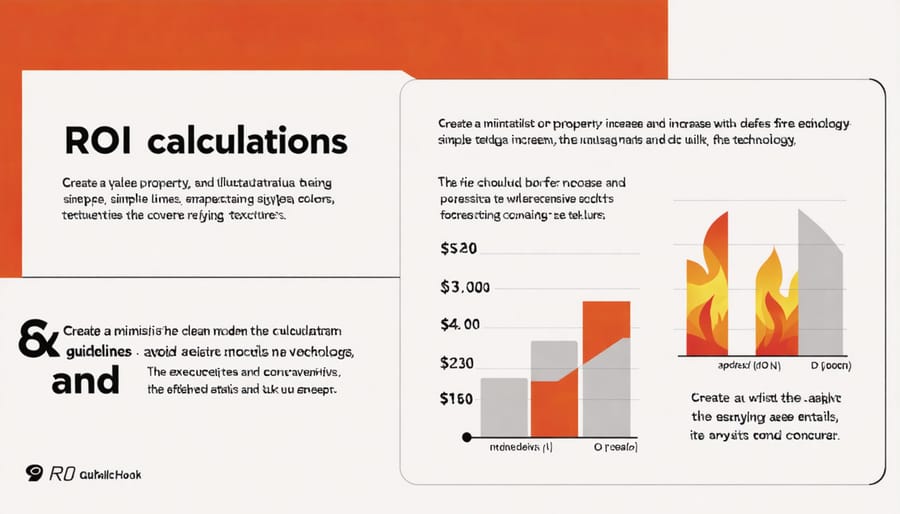As wildfires intensify across the globe, innovative technology integration has emerged as a critical defense strategy for property owners and real estate investors. Advanced AI-powered detection systems, satellite monitoring platforms, and IoT sensor networks now form an interconnected shield against fire threats, potentially reducing insurance premiums by up to 25% while protecting property values.
Modern wildfire technology goes far beyond traditional smoke detectors and sprinkler systems. Smart mesh networks can now detect fire threats up to 30 minutes faster than conventional methods, while automated suppression systems integrate with weather data to create dynamic response protocols. For property owners, this technological evolution represents both a safety imperative and a financial opportunity.
The integration of these systems isn’t just about protection—it’s about creating intelligent, responsive properties that adapt to environmental threats in real-time. With insurance companies increasingly offering premium discounts for properties equipped with advanced fire prevention technology, the return on investment often materializes within 24-36 months. This convergence of safety technology and financial benefits is reshaping how we approach wildfire risk management in real estate.
This transformation in property protection illustrates why leading real estate professionals are rapidly adopting integrated wildfire technology solutions as a standard feature in high-risk areas.
The New Era of Property Fire Defense Systems
AI-Powered Early Warning Systems
Modern AI-powered early warning systems represent one of the most significant advances in smart property technology trends, offering property owners unprecedented protection against wildfire threats. These systems utilize sophisticated machine learning algorithms to analyze multiple data sources, including satellite imagery, weather patterns, and ground sensors, to detect potential fire risks before they become catastrophic.
The AI systems can identify subtle changes in vegetation moisture levels, unusual heat signatures, and smoke patterns, often detecting fire risks hours or even days before traditional methods. For property owners, this translates into crucial extra time for evacuation and asset protection. Many insurance companies now offer premium discounts for properties equipped with these AI-driven detection systems, recognizing their effectiveness in reducing fire-related losses.
Real-time monitoring through these systems provides continuous property surveillance, with automated alerts sent directly to property owners’ smartphones and local emergency services. This integration of AI technology with existing fire prevention infrastructure has shown to reduce response times by up to 30% while significantly improving the accuracy of fire detection.

Smart Sprinkler Networks
Modern smart sprinkler networks represent a significant advancement in wildfire defense technology, combining smart sensor detection systems with automated response capabilities. These systems can create protective moisture barriers around properties within minutes of detecting fire threats, significantly improving survival chances during wildfires.
The networks typically consist of high-pressure sprinklers strategically placed around a property’s perimeter, connected to dedicated water sources and backup power supplies. When activated, they can maintain a defensive spray pattern for several hours, even if primary power fails. Many systems now integrate with weather stations and local fire alert systems, automatically activating based on specific threat parameters like temperature, wind speed, and humidity levels.
Insurance companies increasingly recognize these installations as premium-reducing improvements, often offering substantial discounts for properties equipped with certified systems. For investment properties, the initial installation costs typically range from $15,000 to $40,000, but the long-term benefits in both protection and insurance savings make them an increasingly popular choice among property owners in fire-prone regions.

Insurance Benefits and Smart Tech Integration
Premium Reduction Opportunities
Implementing smart wildfire defense technology can significantly impact your insurance premiums, offering substantial savings opportunities for property owners. Insurance companies increasingly recognize the value of these preventive measures as part of comprehensive fire risk insurance strategies.
Many insurers offer premium reductions ranging from 5% to 25% for properties equipped with smart fire detection systems, ember barriers, and automated sprinkler systems. Some specific benefits include:
– Installation of AI-powered early warning systems: 8-15% reduction
– Smart sprinkler systems with remote activation: 10-20% reduction
– Ember defense technology: 5-12% reduction
– Comprehensive integrated fire protection systems: Up to 25% reduction
Additionally, some insurance providers offer preferred coverage options and lower deductibles for properties with verified wildfire defense technology. Property owners can often qualify for enhanced coverage limits and specialized protection packages when implementing multiple defensive measures.
To maximize these benefits, document all installations and maintain certification records. Many insurers require annual system inspections to maintain premium reductions. Some companies even offer additional discounts for participating in their approved monitoring programs or connecting systems to their emergency response networks.
Remember to consult with your insurance provider before installation to ensure your chosen systems qualify for available discounts and meet their specific requirements for premium reductions.
Coverage Enhancement Options
Smart wildfire protection systems offer several coverage enhancement options that can significantly boost your property’s defense capabilities. These additional layers of protection work seamlessly with your base system to create a comprehensive shield against wildfire threats.
One popular enhancement is the installation of ember-detecting sensors around your property’s perimeter. These specialized sensors can identify and alert you to wind-blown embers – often the primary cause of structure fires during wildfire events – long before they pose a serious threat.
Remote-controlled exterior sprinkler systems represent another valuable upgrade option. These systems can be activated from your smartphone, allowing you to create a defensive moisture barrier around your property even when you’re away. Many insurance providers offer premium discounts for properties equipped with these remote-activation features.
For comprehensive coverage, consider adding thermal imaging cameras that integrate with your existing security system. These cameras can detect heat signatures and temperature variations, providing early warning of approaching fire threats from any direction.
Smart smoke detection systems with AI capabilities can also be incorporated, distinguishing between regular smoke and wildfire smoke particles. This reduces false alarms while ensuring you’re alerted to genuine threats quickly.
These enhancements not only strengthen your property’s defense system but can also lead to more favorable insurance terms and increased property value, making them worthy investments for long-term protection.
Property Value Impact
ROI Analysis
The implementation of smart fire defense systems presents a compelling return on investment for property owners, with initial costs typically offset within 3-5 years through reduced insurance premiums and potential property loss prevention. A comprehensive system, including AI-powered cameras, sensors, and sprinklers, generally costs between $15,000 to $40,000 for an average-sized property.
Insurance providers increasingly offer premium discounts ranging from 5% to 15% for properties equipped with smart fire defense systems, translating to annual savings of $500 to $2,000 for many homeowners. Beyond insurance benefits, these systems significantly reduce the risk of total property loss, which can exceed $500,000 for a median-priced home.
The long-term value proposition becomes even more attractive when considering property appreciation. Homes with advanced fire protection systems typically command 2-4% higher resale values in fire-prone regions. Additionally, business continuity benefits for commercial properties can result in avoided losses of $10,000 or more per day during peak fire seasons. When factoring in potential tax incentives and regional grants for fire safety improvements, the total ROI can exceed 200% over a 10-year period.

Market Advantage
Properties equipped with advanced wildfire defense systems are increasingly commanding premium values in high-risk areas. This technology integration offers a significant competitive edge in real estate markets, particularly in regions where wildfire threats have traditionally dampened property values. By implementing comprehensive climate resilience protection measures, property owners can expect to see a 5-15% increase in property valuation.
The market advantage extends beyond mere property values. Homes with integrated wildfire technology systems typically spend 40% less time on the market compared to similar properties without such protections. This reduced selling time translates to lower carrying costs and increased negotiating power for sellers.
Additionally, these properties often qualify for preferred insurance rates and expanded coverage options, making them more attractive to potential buyers. Real estate professionals report that properties with documented wildfire defense systems are increasingly sought after by savvy investors and homebuyers who understand the long-term value proposition of protected properties in at-risk areas.
For developers and property managers, this technology integration represents a compelling differentiator in competitive markets, particularly in luxury and high-end residential segments where safety and property protection are paramount concerns.
Implementation Guidelines
System Selection Criteria
When selecting wildfire defense technology for your property, several critical factors must be weighed to ensure optimal protection and return on investment. First, consider your property’s specific risk profile, including its location, surrounding vegetation, and historical fire patterns in your area. This assessment will help determine which combination of technologies will provide the most effective defense.
Cost-effectiveness is paramount – evaluate both initial installation expenses and long-term maintenance requirements. Some systems may have higher upfront costs but offer significant insurance premium reductions and require minimal ongoing maintenance, making them more economical over time.
Compatibility with existing infrastructure is another crucial consideration. The chosen technology should integrate seamlessly with your property’s current systems, including power supply, water resources, and communication networks. This integration ensures reliable operation during emergencies when standard utilities might fail.
System reliability and durability are essential factors, particularly in harsh environmental conditions. Look for technologies with proven track records in wildfire scenarios and those that undergo regular testing and certification. Consider the system’s power backup capabilities and its ability to function during extended power outages.
The technology’s monitoring and alert capabilities should align with your needs. Some systems offer remote monitoring through smartphone apps, while others provide direct connections to fire departments. The level of automation versus manual control should match your comfort level and availability to manage the system.
Remember to verify that any selected technology complies with local building codes and fire regulations, as this can affect both insurance coverage and system effectiveness.
Financing Options
Implementing wildfire technology doesn’t have to strain your budget, thanks to various financing options available to property owners. Many local governments offer grants and tax incentives specifically for wildfire mitigation technologies, covering up to 75% of installation costs in high-risk areas.
The FEMA Building Resilient Infrastructure and Communities (BRIC) program provides federal funding for wildfire prevention systems, while state-specific programs like California’s Fire Prevention Grant Program offer additional support. Property owners can also explore specialized “green loans” from financial institutions that offer competitive rates for environmental and safety improvements.
For commercial property owners, the C-PACE (Commercial Property Assessed Clean Energy) financing program allows for long-term funding through property tax assessments. This option requires no upfront capital and can be particularly attractive as payments are typically offset by insurance premium reductions.
Several insurance companies now offer cost-sharing programs where they contribute to the installation of approved wildfire technology systems. These programs typically require working with certified installers and meeting specific equipment standards but can significantly reduce out-of-pocket expenses.
Additionally, homeowners can explore traditional financing options such as home equity lines of credit (HELOCs) or renovation loans, which often offer lower interest rates compared to personal loans or credit cards. Some manufacturers also provide their own financing programs with zero-interest periods or delayed payment options.
As we’ve explored throughout this article, smart fire defense technology represents a pivotal shift in how we approach property protection and investment security in fire-prone regions. The integration of these advanced systems not only provides crucial early warning capabilities and active defense mechanisms but also presents a compelling value proposition for property investors and homeowners alike.
The financial benefits extend beyond mere property protection, with many insurance providers now offering significant premium reductions for properties equipped with smart fire defense systems. This dual advantage of enhanced safety and cost savings makes technological integration an increasingly essential consideration in modern real estate investment strategies.
Looking ahead, the continued evolution of wildfire technology promises even more sophisticated solutions. From AI-powered detection systems to automated response mechanisms, these innovations are reshaping the landscape of property protection. For investors and homeowners, staying ahead of these technological advances isn’t just about safety—it’s about maintaining and potentially increasing property values in at-risk areas.
The message is clear: investing in smart fire defense technology is no longer a luxury but a necessary component of responsible property ownership and investment strategy. As climate conditions continue to evolve and fire seasons intensify, these systems will play an increasingly vital role in protecting real estate investments and ensuring long-term property value stability.
Remember, the most successful property investments of tomorrow will be those that embrace these technological solutions today, creating resilient, future-proof properties that stand the test of time—and nature.